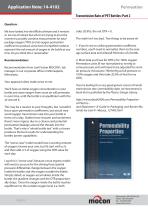 Website:
AMETEK MOCON
Website:
AMETEK MOCON
Group: AMETEK
Catalog excerpts

Permeation Transmission Rate of PET Bottles: Part 1 Question: Is there a (simple) method for shelf life oxygen transmission based on a permeation factor of the resin/preform of a PET container for ice tea. If you’re looking for a very good generic source of innate transmission rate / permeability data, we recommend a book that is published by the Plastics Design Library. Recommendation from Joel Fischer MOCON’s lab manager in our corporate office in Minneapolis, Minnesota. Establishing a shelf life model based upon resin or preform information, can be difficult. The reason is that the final bottle structure will have its own surface area, thickness and crustallinity. The resin and preform are fairly amorphous and lack the crystallinity and orientation that impact the diffucsion of oxygen in the formed bottle. Therefor a lot of the gas barries is due to the processing of the bottle (stretch ratios and such) and could be difficult to predict. I have two generic recommendations: 1. You can utilize the generic information that’s listed in the book we referenced (Permeability Properties of Plastics and Elastomers) and normalize the values within that book to your material choice and beverage bottle size. 2. There is a commerical model program called the MRule. It was prodcued by former carbonated soft drink material engineer (Mark Rule) and has a lot of inputs for variability of polymer type, size, crystallinity ... etc. My perspective is that the model is a good “ball park” estimate for gaugin materials. However, when companies are engineering the heck our of polymers and trying to minimize the packaging costs via lighteighing bottles, the acutal OTR data from such bottles is best for gauging shelf life. Minneapolis, MN 55428 USA Phone: 763.493.6370 Fax: 763.493.6358 www.mo
Open the catalog to page 1
Permeation Transmission Rate of PET Bottles: Part 2 Question: We have looked into the MRule software and it remains to be one of interest but what I am trying to do at the moment is possibly combine measurements for total package oxygen (TPO) and an oxygen permeation coefficient to produce some kind of simplified model to represent the real amount of oxygen in the bottle at any time. Do you think this is reasonable? 2. Most data you’ll see for OTR is for 100% oxygen. Permeation units (if not normalized to mmHg or some pressure unit) will need to be adjusted for room air pressure (I’d assume...
Open the catalog to page 2All AMETEK MOCON catalogs and technical brochures
-
Dansensor ISM-3
2 Pages
-
PERMATRAN-W Model 101 K
4 Pages
-
AQUATRAN 3/40
4 Pages
-
Dansensor MAP Check 3 Vacuum
2 Pages
-
Dansensor LeakMatic II
2 Pages
-
The ProSpect Advantage
2 Pages
-
Optimize Butter Production
3 Pages
-
Dansensor LeakPointer H20
2 Pages
-
PERMATRAN-C 4/30 Analyzer
4 Pages
-
OX-TRAN 2/48 Series
4 Pages
-
Dansensor Lippke VC1400
2 Pages
-
Toxic Gas Monitoring
4 Pages
-
Trace Gases In Ambient Air
4 Pages
-
Surface Logging
4 Pages
-
Impurities In Specialty Gas
4 Pages
-
Baseline VOC-TRAQ II
4 Pages
-
OX-TRAN 2/28 H
4 Pages
-
AQUATRAN 3/38 H
4 Pages
-
PERMATRAN-W® Model 101K
4 Pages
-
MOCON® BASELINE® PRODUCTS
2 Pages
-
PERMATRAN-C® Model 4/41
2 Pages
-
OX-TRAN Model 2/12 Series
2 Pages
-
OX-TRAN® Model 2/40 Series
4 Pages
-
OX-TRAN Model 2/22 Series
2 Pages
-
Oxygen and Water Vapor
4 Pages
-
MAP Gas Mixtures Poster
1 Pages
-
Dansensor ISM 3
2 Pages
-
PERMATRAN-W Model 3/34
2 Pages
-
BevAlert®
6 Pages
-
AQUATRAN® Model 3
2 Pages
Archived catalogs
-
PERMATRAN-W Model 3/61
4 Pages
-
PERMATRAN-W® Model 700
4 Pages
-
PERMATRAN-W® Model 398
2 Pages
-
OX-TRAN® Model 2/61
4 Pages
-
MultiCheck Series
4 Pages
-
OX-TRAN Model 2/61
4 Pages
-
OX-TRAN Model 702
4 Pages
-
OX-TRAN Model 2/10
2 Pages
-
piD-TECH® eVx
4 Pages
-
CheckPoint 3
2 Pages
































































































